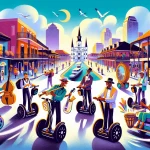New Orleans, the captivating city along the Mississippi River, offers a unique tapestry of cultural experiences that draws millions of visitors yearly. To fully immerse yourself in the city’s charm, understanding the various transportation options and navigating efficiently and safely is crucial.
In This Article
TL;DR
- New Orleans provides diverse transportation choices, including public transit, streetcars, biking, walking, ride-sharing, taxis, car rentals, and ferry services.
- The optimal mode of transport depends on the area you’re exploring and the time of day, as traffic patterns and crowd levels can vary significantly.
- To navigate safely and efficiently, familiarize yourself with the neighborhood layouts, be aware of peak travel times, and follow local safety guidelines.
Public Transportation in New Orleans
The New Orleans Regional Transit Authority (RTA) operates an extensive network of buses and streetcars that cover much of the city. The RTA system is an affordable and convenient way to explore New Orleans, especially for those without access to a car.
To make the most of the RTA services, download the RTA mobile app, which provides real-time tracking and schedules for buses and streetcars. Fares for the RTA system are $1.25 per ride, with options for day passes ($3) and 3-day passes ($9) available for visitors.
The Streetcar System
St. Charles Line
New Orleans’ iconic streetcars are not only a charming mode of transportation but also a piece of the city’s rich history. The streetcar system consists of four distinct lines: St. Charles, Canal Street, Riverfront, and Rampart-St. Claude.
The St. Charles Line, the oldest continuously operating streetcar line in the world, takes you through the picturesque Garden District and Uptown neighborhoods. When using streetcars during peak hours, be prepared for crowded cars and potential delays. To avoid long wait times, consider traveling during off-peak hours or opting for an alternative mode of transportation.
Canal Street Line
The Canal Street Line connects the French Quarter with the cemeteries and the Mid-City area.
Riverfront Line
The Riverfront Line runs along the Mississippi River, offering stunning views of the city’s skyline.
Rampart-St. Claude Line
The Rampart-St. Claude Line traverses the historic Tremé neighborhood and provides access to the popular French Quarter.
Biking in New Orleans
New Orleans has become increasingly bike-friendly in recent years, with the expansion of dedicated bike lanes and the growing popularity of bike-sharing services like Blue Bikes. Biking is a practical and enjoyable way to explore the city’s flat terrain and vibrant neighborhoods.
Blue Bikes, the city’s official bike-share program, offers over 700 bikes at 70+ stations throughout New Orleans. Users can purchase a pass through the Blue Bikes app or at any station kiosk. Prices start at $8 for a day pass, which includes unlimited 60-minute rides.
When biking in New Orleans, always wear a helmet, follow traffic laws, and use hand signals when turning. Some notable bike-friendly routes include the Mississippi River Trail, the Lafitte Greenway, and the Tammany Trace.
Walking as a Travel Option
One of the best ways to experience New Orleans’ unique character is by exploring on foot. Many of the city’s most iconic neighborhoods, such as the French Quarter and the Garden District, are highly walkable and filled with historic architecture, lively street performers, and hidden gems.
Popular walking routes include the French Quarter’s Bourbon Street and Royal Street, known for their vibrant nightlife and antique shops, respectively. In the Garden District, stroll along the oak-lined streets and admire the opulent mansions and lush gardens.
When walking in busy areas, be mindful of your surroundings, stick to well-lit streets, and keep valuables secure. During the summer months, be prepared for high temperatures and humidity, and stay hydrated throughout your walk.
Ride-Sharing and Taxis
Ride-sharing services like Uber and Lyft have become increasingly popular in New Orleans, offering a convenient and affordable alternative to traditional taxis. These services are particularly useful for reaching areas not well-served by public transportation or for late-night travel.
To use ride-sharing services, download the respective app and create an account. When requesting a ride, be sure to check the estimated fare and wait time before confirming your booking. It’s also a good idea to share your ride details with a friend or family member for added safety.
Traditional taxis are also readily available throughout the city, particularly in tourist-heavy areas like the French Quarter and Central Business District. Taxis in New Orleans charge a base fare of $3.50, with an additional $2.00 per mile and $0.40 per minute of waiting time. Tipping your driver 15-20% is customary.
Car Rentals and Driving
While renting a car can offer greater flexibility and convenience, driving in New Orleans comes with its own set of challenges. Traffic congestion, limited parking, and narrow, one-way streets can make navigating the city by car a stressful experience, particularly for those unfamiliar with the area.
If you do choose to rent a car, be aware of the city’s unique parking regulations and street cleaning schedules to avoid tickets and towing. Many neighborhoods, such as the French Quarter and Marigny, have limited street parking and rely heavily on paid lots and garages.
When driving in New Orleans, be prepared for sudden stops, pedestrians, and cyclists. Avoid driving during rush hour (7-9 AM and 4-6 PM) and major events like Mardi Gras and Jazz Fest, when road closures and heavy traffic are common.
River and Ferry Services
New Orleans’ location on the Mississippi River offers a unique opportunity to explore the city by water. The New Orleans Regional Transit Authority operates two ferry lines: the Canal Street/Algiers Point Ferry and the Lower Algiers/Chalmette Ferry.
The Canal Street/Algiers Point Ferry connects the foot of Canal Street in the French Quarter with the historic Algiers Point neighborhood, offering stunning views of the city skyline along the way. Address: Canal St & Algiers Rd, New Orleans, LA 70130
Phone: (504) 827-4787
The Lower Algiers/Chalmette Ferry runs between Lower Algiers and Chalmette, providing access to the Chalmette Battlefield and National Cemetery.
Ferry fares are $2 per person, with reduced fares available for seniors, disabled riders, and children. Ferries run daily, with schedules varying by route and season. Combining ferry travel with other modes of transportation, such as biking or walking, can make for a memorable and efficient way to explore the city.
Navigating Special Events and Festivals
New Orleans is known for its vibrant festivals and events, such as Mardi Gras and Jazz Fest, which draw millions of visitors each year. During these times, transportation in the city can be significantly impacted, with road closures, detours, and heavy foot traffic.
To navigate the city during major events, plan your route in advance and allow extra time for travel. Consider using public transportation or walking to avoid traffic congestion and parking difficulties. Be prepared for crowded streetcars and buses, and have a backup plan in case your preferred mode of transport is unavailable.
For Mardi Gras, familiarize yourself with the parade routes and schedules, and choose a viewing spot that is easily accessible by foot or public transit. During Jazz Fest, consider using the festival’s shuttle service, which runs between the Fair Grounds and various locations throughout the city.
Expert Tips and Local Insights
To make the most of your time in New Orleans, consider the following expert tips and local insights:
- Avoid traveling during rush hour (7-9 AM and 4-6 PM) when possible, as traffic congestion can significantly increase travel times.
- Take advantage of the city’s flat terrain and bike-friendly infrastructure by renting a bike or using the Blue Bikes bike-share program.
- Explore the city’s hidden gems and lesser-known neighborhoods, such as Bywater, Marigny, and Mid-City, which offer unique experiences and a break from the tourist crowds.
- When using public transportation, have exact change or a pre-loaded pass ready to avoid delays.
- Be mindful of your surroundings and take standard safety precautions, especially when walking or biking at night.
By understanding the various transportation options available and following these expert tips, you’ll be well-equipped to navigate New Orleans like a local and make the most of your time in this captivating city.






